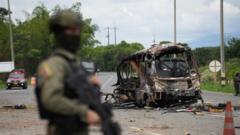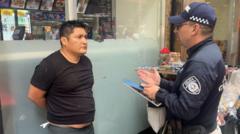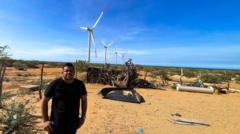**Local authorities report multiple attacks, suspected ties to FARC, as the nation's security crisis deepens.**
**Colombia Under Siege: Four Confirmed Dead in Recent Attacks**

**Colombia Under Siege: Four Confirmed Dead in Recent Attacks**
**Wave of violence in southwestern Colombia raises alarm, with police among the fatalities.**
In a shocking surge of violence, at least four individuals have lost their lives in a series of bombings and shootings in southwestern Colombia, according to recent reports from local media. Among the deceased are two police officers, highlighting the urgent threat posed to law enforcement in the region.
The hostilities targeted key locations, including the city of Cali—Colombia’s third-largest urban center—as well as neighboring towns. The attacks featured a frightening arsenal of weaponry, including car and motorcycle bombs, gunfire, and even what is suspected to be a drone assault, aimed at police stations, municipal buildings, and civilian areas. The unrest reflects a worsening security crisis gripping the South American nation, with media outlets suggesting a connection to factions of the Revolutionary Armed Forces of Colombia (FARC), a previously significant guerrilla army that had ostensibly transitioned to political engagement.
While local news reports indicate a concerning number of injuries, the casualty details remain unclear as the situation evolves. The Colombian Ministry of Defence has confirmed that 19 separate attacks occurred in the southwestern parts of the country, with a breakdown showing 12 incidents in the Cauca region and seven in Valle del Cauca.
In a statement shared on social media, the ministry characterized the violence as a desperate response from illegal armed groups to the military and police's extensive operations—efforts aimed at dismantling their criminal enterprises and economic foundations. This latest wave of terror follows just days after an assassination attempt on presidential candidate Miguel Uribe Turbay in Bogota during an event with his supporters.
The mayor of Cali has drawn parallels between the current violence and the city's troubled past in 1989, a time overshadowed by rampant drug trafficking and cartel-related violence—an evocative reminder of the ongoing challenges Colombia continues to face in securing peace and stability.
The hostilities targeted key locations, including the city of Cali—Colombia’s third-largest urban center—as well as neighboring towns. The attacks featured a frightening arsenal of weaponry, including car and motorcycle bombs, gunfire, and even what is suspected to be a drone assault, aimed at police stations, municipal buildings, and civilian areas. The unrest reflects a worsening security crisis gripping the South American nation, with media outlets suggesting a connection to factions of the Revolutionary Armed Forces of Colombia (FARC), a previously significant guerrilla army that had ostensibly transitioned to political engagement.
While local news reports indicate a concerning number of injuries, the casualty details remain unclear as the situation evolves. The Colombian Ministry of Defence has confirmed that 19 separate attacks occurred in the southwestern parts of the country, with a breakdown showing 12 incidents in the Cauca region and seven in Valle del Cauca.
In a statement shared on social media, the ministry characterized the violence as a desperate response from illegal armed groups to the military and police's extensive operations—efforts aimed at dismantling their criminal enterprises and economic foundations. This latest wave of terror follows just days after an assassination attempt on presidential candidate Miguel Uribe Turbay in Bogota during an event with his supporters.
The mayor of Cali has drawn parallels between the current violence and the city's troubled past in 1989, a time overshadowed by rampant drug trafficking and cartel-related violence—an evocative reminder of the ongoing challenges Colombia continues to face in securing peace and stability.




















